|
Visiting
Mendoza, Argentina
Part 6: Achaval Ferrer

Does
Argentina have a fine wine dimension? That’s a good question. I
think I’d answer ‘yes’, and largely because of the amazing
wines of Achaval Ferrer, which, for me, is Argentina's most
impressive producer. I’d tried their wines in London, and been
blown away by them, so I was delighted to be able to visit the
winery, even though it was in the rather busy time of vintage.
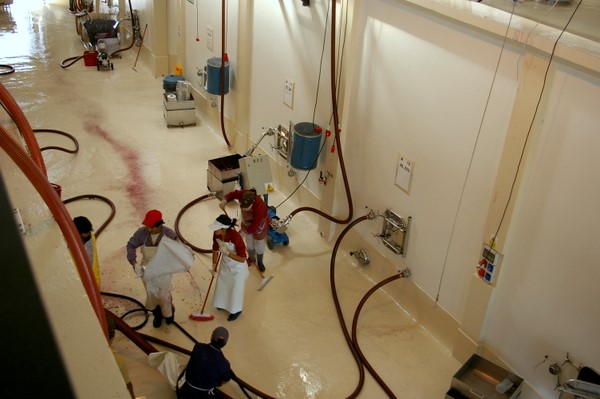
When
we arrived, the winery was bustling with activity. Santiago Achaval,
one of the partners of this venture, took us through the winery and
then hosted our tasting. (The other two partners are Manuel Ferrerer
and winemaker Roberto Cipresso.)
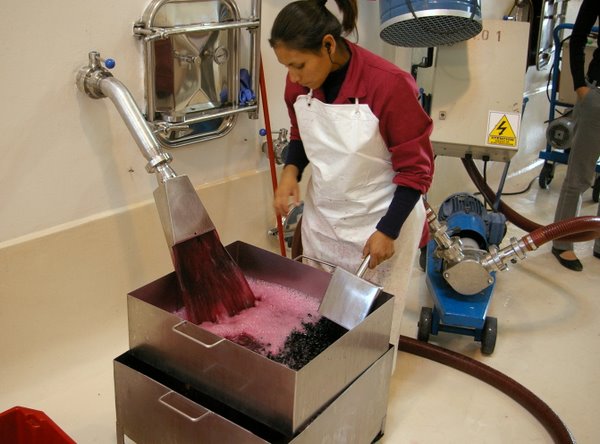
It's
a slightly unusual winery. Although it's modern – it was only
finished in 2006 – it doesn't look like a typical brand new
winery. The fermentation vessels are all epoxy-lined concrete tanks
– with no stainless steel in sight. No whites are made here, just
reds. Also, there are no drains, because Santiago reckons that these
can lead to bacterial problems. Everything is painted in light
colours so any dirt can easily be seen.
One
of the problems with concrete is that it is a good insulator, and so
the fermentations can get a bit warm. 'We only cool down when the
fermentation temperature touches 33 °C', says Santiago. 'We like
warm ferments because the yeast works on a cycle of its own
activity. With the yeast in a comfortable environment, we get better
extraction.' When cooling down is needed, the use of a heat
exchanger (see the video, and picture below) is enough. Pump-overs
and delestage are carried out. Cold soak is not usually used, and a
day after fermentation finishes the wines are pressed. They’re not
fans of extended macerations here.
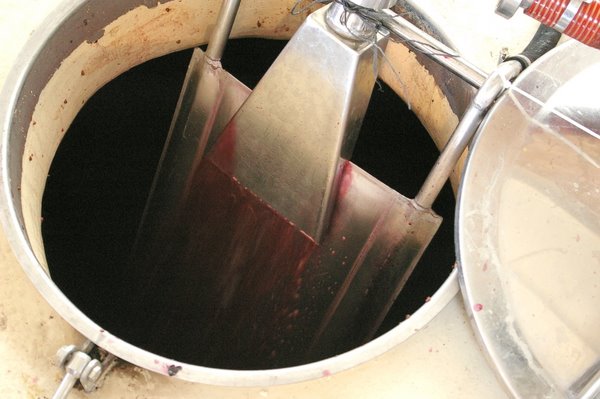
Racking
only takes place there are serious reductive problems that battonage
can't cure. Barrels are topped up every week.
After
starting his career as an accountant, Santiago did an MBA at
Stanford (class of 89), and spent 9 years making money before he
turned to wine. He'd liked to have got into wine sooner, but he
still had to complete his contract with the company that financed
his MBA. He found his first piece of vineyard land in 1998, and
first vintage was 1999. Now he owns 40 hectares of vineyards and
leases another 45. These are deliberately managed to restrict
yields. In the vineyards, the yields are low. For the entry level
Malbec they are 5000 kg/ha, for Quimera they are 2500 kg/ha and for
the single vineyard wines they are 1800 kg/ha. Production is 15 000
cases typically per year, depending on hail. 40% of this finds its
way to the USA.
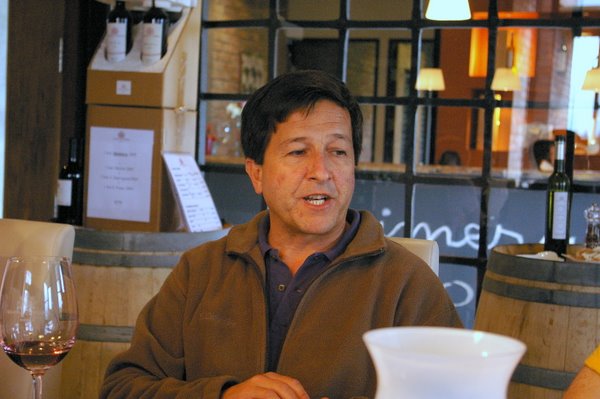 Santiago
Achaval
Santiago
Achaval
‘We
harvest about three weeks before everyone else’, says Santiago.
‘It’s the effect of low yields. As soon as we have ripe tannins
we pick, and we usually have low sugars with nice natural acidity’.
Santiago
describes himself and his partners as 'Old vine, low yield, Malbec
lunatics'. He adds that, 'when we do double yields, we notice the
balance is different'. How are they doing? 'We are profitable but
don't have a positive cashflow yet'.
'We
decided to make every wine an expression – a ‘spotlight’ –
of old vine Malbec', explains Santiago. He has three different ideas
of Malbec in Mendoza. The first spotlight is Malbec as fruit:
correct varietal expression of Malbec. The second is 'spotlight':
pursuit of a perfect wine with complexity and balance. This is
Quimera, which translates as foolish – pursuing the unobtainable.
The third spotlight is Malbec as a translator of the character of
the land, and this is represented by three single-vineyard old vine
Malbecs.
‘I
want to achieve a wine that is balanced and belies its size’,
Santiago adds, ‘with nothing sticking out. We try to make wines
that are drinkable on release, but we think we are behaving in such
a fashion in the winery that our wines will age well. We try to
respect the integrity of the wine.’
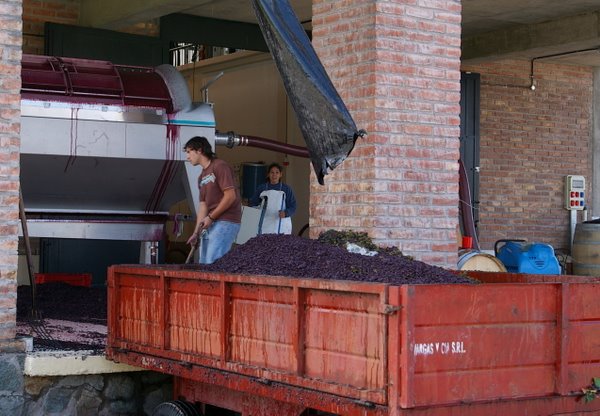
In
the vineyard, they are virtually organic. No synthetic fertilizers
are used, just manure. ‘We only use cow manure: goat and chicken
manure is too quick and vigorous’, says Santiago. ‘The only
thing between us and organics is our herbicide use. Without
herbicides we’d need to till, and this would use gas and oil, and
compact the soil’.
Hail
is a problem here. In 2005 and 2006 they lost the entire Bellavista
vineyard crop to hail. But they don’t like netting because of the
shade effect. Black netting gives 15% shade, and white 8% shade (but
this is 10% in reality because dust gathers on it). They are insured
against total catastrophe by having their vineyards spread out
geographically.
Achaval
Ferrer Malbec 2007 Mendoza
’We
made this because we couldn’t balance some blocks to low yields’,
says Santiago. ‘We got a very nice wine’. Beautifully open and
perfumed. A bit violetty with lovely perfume. The palate shows ripe,
elegant fruit with lovely purity. Thrillingly joyful and bright.
90/100
Achaval
Ferrer Malbec 2006 Mendoza
Elegant,
meaty and perfumed with a lovely floral character. The palate is
elegant and smooth with lovely pure, expressive fruit. It’s almost
a Burgundian expression of Malbec. Fantastic: fresh and delicious.
91/100
Achaval
Ferrer Quimera 2007 (barrel sample)
This
is a blend of 35% Malbec, 30% Merlot, 25% Cabernet Sauvignon and 10%
Cabernet Franc. Very sweet and pure – almost jammy. Very primary
and perfumed with lushness and sweetness. The palate is soft and
pure with really smooth texture and fine tannins. Good concentration
here and lots of sweet fruit. 90–93/100
Achaval
Ferrer Quimera 2005 Mendoza
Beautifully
elegant, perfumed red/black fruits nose with some sweetness. Fresh
and bright. The palate is supremely elegant and pure with lovely
smooth tannins. Fantastically expressive and well balanced. Really
Burgundian. 93/100
Now, the three single vineyard wines. Mirado is 37 km
south east of the winery at 700 metres altitude. Bellavista was
planted in 1910. And Altamira is at the southern tip of the Uco
Valley. We
don't set out to create any differences among these wines, says
Santiago. It's like a controlled experiment, where the only variable
is the location.
Achaval
Ferrer Mirado 2007 (barrel sample)
Beautifully
sweet, pure, elegant smooth red fruits nose. Lovely intensity of
raspberry fruit on the palate with firm spicy tannins and great
concentration. Some minerality, too. It's tannic with great
potential. 91-94/100
Achaval
Ferrer Mirado 2005 Mendoza
Beautifully
perfumed nose showing elegant, vibrant red berry and black fruits,
with real purity. The smooth, softly structured palate is elegant
with lovely purity and freshness as well as good tannic structure.
Bright and fresh with lovely elegance. 93/100
Achaval
Ferrer Bellavista 2007 Mendoza (barrel sample)
Sweet
and lush with real focus and purity, and quite some depth. Very
sweet, powerful fruit. It's a robust, fairly tannic wine with lots
of presence. Bigger, with more structure, darker fruits and less
floral character than the other wines. 90-93/100
Achaval
Ferrer Altamira 2007 Mendoza (barrel sample)
Really
beautiful nose is perfumed with some violet notes and well defined,
fresh fruit character. The palate is rich with dense structure under
the smooth fruit. Quite elegant, Brilliant structure but not at the
cost of elegance. 92-95/100
Achaval
Ferrer Altamira 2006 Mendoza
Wonderfully
perfumed nose with some meaty, spicy depth to the pure red and black
fruits. Nicely poised. The palate combines supremely elegant, smooth
fruit and soft texture with some lovely structure. Bright, fresh and
pure. Elegant and structured with a long life ahead of it.
Brilliant. 95/100
Achaval
Ferrer Mirador 2000 Mendoza
Smooth
dark fruits nose with some complex spiciness. Really expressive:
earthy and meaty. The palate is rich and dense with lovely
concentration and earthy, spicy complexity. Evolving beautifully and
drinking well now. 93/100
A
short video of the visit:
Wines tasted 03/08
Find these wines with wine-searcher.com
Back
to top
|

